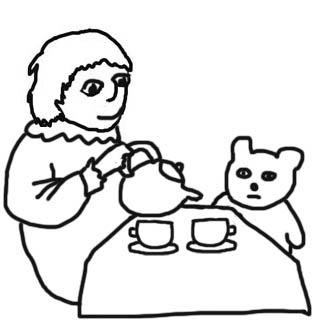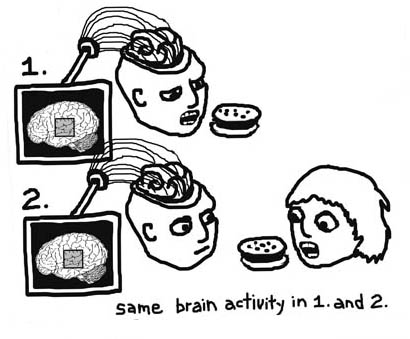Merlin Donald, a cognitive neuroscientist with a background in philosophy, says:
"A mimetic act is basically a motor performance that reflects the perceived event structure of the world, and its motoric aspect makes its content a public, that is, a potentially cultural, expression."
Merlin Donald, “Imitation and Mimesis,” in Perspectives on Imitation, From Neuroscience to Social Science, Vol 2, Hurley, Susan and Chater, Nick eds. (Cambridge: MIT Press, 2005) p. 281
"Mimesis is the reduplication of an event for communicative purposes. Mimesis requires that the audience can be taken into account. It also demands taking a third-person perspective on the actor's own behaviour."
Merlin Donald, ibid., p. 286
"Mimesis is an analogue or holistic style of thought that is more basic to our uniquely human way of thinking than language or logic. Indeed, on present evidence language and logic evolved much later, from a mimetic platform. Mimesis is a foundation skill that arrived early in evolution, and defined the human style. The components of mimetic cognition are present to some degree in primates, but are vastly more developed in humans. this makes mimetic culture a logical, but radical, extension of the primate mind. It remains an important force in human affairs, and produces such typically human cognitive patterns as ritual, skill, gesture, tribal identification, personal style, and public spectacle. It explains our irresistable tendency to imitate one another and conform to patterns of group behaviour, especially group emotional expression. It sets the tone of human social life, and it is the ultimate driving force behind art, which might be viewed as the ultimate refinement of the mimetic mode."
Merlin Donald, "Art and Congitive Evolution," in The Artful Mind, Mark Turner, ed., (New York: Oxford University Press, 2006) p.15
... do not be fooled by imitations ... the Bird flew ... Krupa took us higher .... Joni and Dylan shook the handcuffs off ... off course we are bound by the wires and mind forged manicals coming down throught the ages ... but good lord, we kick at the darkness til' it bleeds daylight ..... thanks Cockburn ........
London
by William Blake
I wander through each chartered street,
Near where the chartered Thames does flow,
And mark in every face I meet,
Marks of weakness, marks of woe.
In every cry of every man,
In every infant's cry of fear,
In every voice, in every ban,
The mind-forged manacles I hear:
How the chimney-sweeper's cry
Every blackening church appals,
And the hapless soldier's sigh
Runs in blood down palace-walls.
But most, through midnight streets I hear
How the youthful harlot's curse
Blasts the new-born infant's tear,
And blights with plagues the marriage-hearse.
I'm interested in these definitions of mimesis that go beyond imitation. It's not just about visual similarity, it's a more fundamental embodiement of meaning, at the root of all our communication. As Donald says, "the only output of any nervous system is muscle movement."
The other thing I like about Donald is that he believes culture (based on mimetic communication) came before language evolutionarily. And that culture, language and society have all been evolving together, as a package. Our brains have the capacity for language, but in isolation we don't learn it. We need each other.
Maybe that constitutes a set of mind-forged manacles. But I don't think mimesis is one bit restrictive.
i agree sally. we are born and raised in our contexts (environment, culture, family, education ...) and our 'free will' operates within these contexts .... but what a bright light shines when creative outbursts lead us into the new ...... and yet, likely in most ways:
"The world is too much with us" - William Wordsworth
Nervous systems also output hormones. By way of the cortex thalamus hypothalamus pituitary connection. Hence fight or flight. See tiger, burning bright or otherwise, release adrenaline, run away fast.
ahah! technical expertise. I need to know how come, when mirror neurons fire, our brains don't just tell our motor control to go for it, in which case we'd be mimicking each other all the time. Where are the inhibitors? I scanned my outdated garage-sale anatomy book and I can't understand all the terms but it seems like some of this work might happen in the spine. Also it seems like there is grey matter in the spine (eew). Galena-G, can you shed any light?
Well now, them mirror neurons, they didn't have them in my day(mimesis either). So I am talking off the top of my head.
Yawning sounds like a nice simple model, yawn and the room yawns with you.(er, there actually is absolutely no connection between these two sentences) There are a few inhibitory types of molecules floating around the brain, known as reuptake inhibitors. Some of them sustain a particular happening by stopping the resorption of the particular neurotransmitters responsible for the effect. This is not an area of expertise for me, I will try to do some reading, see if I can be less guarded
cool! thanks.
I start yawning if I imagine someone yawning. The word yawn makes me yawn. So everytime I read galengalaxian's comment about yawning I yawn and I'm not bored or tired.
I wonder if that could be weaponised.
(come on, someone has thought that before)
Like the funniest joke in the world.

|
|
 |
Mimesis
"A mimetic act is basically a motor performance that reflects the perceived event structure of the world, and its motoric aspect makes its content a public, that is, a potentially cultural, expression."
"Mimesis is the reduplication of an event for communicative purposes. Mimesis requires that the audience can be taken into account. It also demands taking a third-person perspective on the actor's own behaviour."
Merlin Donald, “Imitation and Mimesis,” in Perspectives on Imitation, From Neuroscience to Social Science, Vol 2, Hurley, Susan and Chater, Nick eds. (Cambridge: MIT Press, 2005)
|
|
Mirror Neurons
"Mirror neurons are a particular class of visuomotor neurons, originally discovered in area F5 of the monkey premotor cortex, that discharge both when the monkey does a particular action and when it observes another individual (monkey or human) doing a similar action."
Giacomo Rizzolatti and Laila Craighero, “The mirror-neuron system,” in Annual Review of Neuroscience, issue 27 (2004)
|
|
Merlin Donald, a cognitive neuroscientist with a background in philosophy, says:
- sally mckay 2-29-2008 5:48 pm
... do not be fooled by imitations ... the Bird flew ... Krupa took us higher .... Joni and Dylan shook the handcuffs off ... off course we are bound by the wires and mind forged manicals coming down throught the ages ... but good lord, we kick at the darkness til' it bleeds daylight ..... thanks Cockburn ........
- the bru (guest) 3-02-2008 12:14 am
London
by William Blake
I wander through each chartered street,
Near where the chartered Thames does flow,
And mark in every face I meet,
Marks of weakness, marks of woe.
In every cry of every man,
In every infant's cry of fear,
In every voice, in every ban,
The mind-forged manacles I hear:
How the chimney-sweeper's cry
Every blackening church appals,
And the hapless soldier's sigh
Runs in blood down palace-walls.
But most, through midnight streets I hear
How the youthful harlot's curse
Blasts the new-born infant's tear,
And blights with plagues the marriage-hearse.
- The mind-forged manacles I hea (guest) 3-02-2008 12:18 am
I'm interested in these definitions of mimesis that go beyond imitation. It's not just about visual similarity, it's a more fundamental embodiement of meaning, at the root of all our communication. As Donald says, "the only output of any nervous system is muscle movement."
The other thing I like about Donald is that he believes culture (based on mimetic communication) came before language evolutionarily. And that culture, language and society have all been evolving together, as a package. Our brains have the capacity for language, but in isolation we don't learn it. We need each other.
Maybe that constitutes a set of mind-forged manacles. But I don't think mimesis is one bit restrictive.
- sally mckay 3-02-2008 2:30 am
i agree sally. we are born and raised in our contexts (environment, culture, family, education ...) and our 'free will' operates within these contexts .... but what a bright light shines when creative outbursts lead us into the new ...... and yet, likely in most ways:
"The world is too much with us" - William Wordsworth
- the bru (guest) 3-03-2008 6:53 am
Nervous systems also output hormones. By way of the cortex thalamus hypothalamus pituitary connection. Hence fight or flight. See tiger, burning bright or otherwise, release adrenaline, run away fast.
- galenagalaxian 3-04-2008 3:57 am
ahah! technical expertise. I need to know how come, when mirror neurons fire, our brains don't just tell our motor control to go for it, in which case we'd be mimicking each other all the time. Where are the inhibitors? I scanned my outdated garage-sale anatomy book and I can't understand all the terms but it seems like some of this work might happen in the spine. Also it seems like there is grey matter in the spine (eew). Galena-G, can you shed any light?
- sally mckay 3-04-2008 4:17 am
Well now, them mirror neurons, they didn't have them in my day(mimesis either). So I am talking off the top of my head.
Yawning sounds like a nice simple model, yawn and the room yawns with you.(er, there actually is absolutely no connection between these two sentences) There are a few inhibitory types of molecules floating around the brain, known as reuptake inhibitors. Some of them sustain a particular happening by stopping the resorption of the particular neurotransmitters responsible for the effect. This is not an area of expertise for me, I will try to do some reading, see if I can be less guarded
- galenagalaxian 3-04-2008 6:45 am
cool! thanks.
- sally mckay 3-04-2008 5:29 pm
I start yawning if I imagine someone yawning. The word yawn makes me yawn. So everytime I read galengalaxian's comment about yawning I yawn and I'm not bored or tired.
I wonder if that could be weaponised.
(come on, someone has thought that before)
- L.M. 3-04-2008 8:03 pm
Like the funniest joke in the world.
- sally mckay 3-04-2008 9:01 pm
"A mimetic act is basically a motor performance that reflects the perceived event structure of the world, and its motoric aspect makes its content a public, that is, a potentially cultural, expression."
"Mimesis is the reduplication of an event for communicative purposes. Mimesis requires that the audience can be taken into account. It also demands taking a third-person perspective on the actor's own behaviour."
Merlin Donald, “Imitation and Mimesis,” in Perspectives on Imitation, From Neuroscience to Social Science, Vol 2, Hurley, Susan and Chater, Nick eds. (Cambridge: MIT Press, 2005)
"Mirror neurons are a particular class of visuomotor neurons, originally discovered in area F5 of the monkey premotor cortex, that discharge both when the monkey does a particular action and when it observes another individual (monkey or human) doing a similar action."
Giacomo Rizzolatti and Laila Craighero, “The mirror-neuron system,” in Annual Review of Neuroscience, issue 27 (2004)
- sally mckay 3-18-2008 6:37 pm